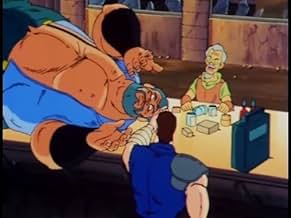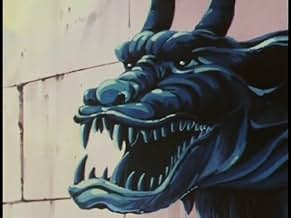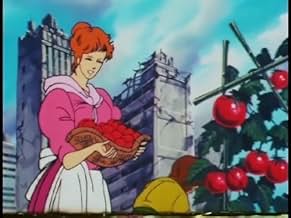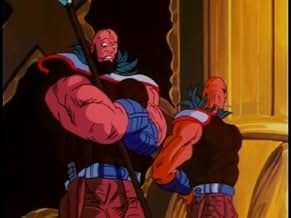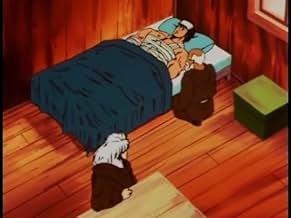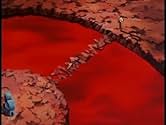PUNTUACIÓN EN IMDb
8,1/10
4 mil
TU PUNTUACIÓN
Después de que una guerra nuclear convierta la Tierra en un páramo sin ley, Kenshiro, un practicante del mortífero arte maestro "Hokuto Shinken", lucha contra una sucesión de guerreros tirán... Leer todoDespués de que una guerra nuclear convierta la Tierra en un páramo sin ley, Kenshiro, un practicante del mortífero arte maestro "Hokuto Shinken", lucha contra una sucesión de guerreros tiránicos para restablecer el orden.Después de que una guerra nuclear convierta la Tierra en un páramo sin ley, Kenshiro, un practicante del mortífero arte maestro "Hokuto Shinken", lucha contra una sucesión de guerreros tiránicos para restablecer el orden.
Explorar episodios
Reseñas destacadas
Wow....just finished the 109 episodes ; this story in not only amazing by its dept and maturity make it one of the best manga that I ever seen.
I recommand that you look at this serie before anything else of the Hokuto.
I recommand that you look at this serie before anything else of the Hokuto.
Fist of the north star is easily my favorite anime movie ever. The film is set in a post apocalyptic wasteland where Ken the fist of the north star searches for his kidnapped girlfriend after being brutally beaten and thrown in a chasm. There's lot's more to it than that though, He has some evil brothers that want to kill him because he is the true prophet and they want his title. Ken joins up with a couple of kids and a deadly guy named ray who slices his enemies apart in some of the most brutal violence in film history. The intensity of the action alone in this movie makes it worth seeing. You see characters screaming battle cries and destroying cities with their fists, slicing and dicing they're enemies apart graphically, and causing bad guys' heads to explode with ken's touch of death. The plot although not explained well enough sometimes, is also very good and the voice acting is also good (look for the voice of the guy who played the father in the fresh prince of bell air as the leader of the guys in bear hides.) The animation dosen't flow flawlessly like in something like ninja scroll or akira but as in a lot of anime with limited budgets they make it look excellent with a minimalist style. The drawings are superb and add to the epicness of the story giving the characters huge pumped up bodies and absurd amounts of power. (punching over buildings, breaking tables due to intense mental powers, crushing peoples heads effortlessly) Some people might not like the over the top presentation of characters being fifty feet tall in one scene and then being in proportion to everyone else the next, but you must understand this is just to present the terrifying presence and power of these characters. I think it's brilliant. Rent it at all costs!!
PS The rapper Jeru the damaja samples and quotes the opening voiceover of fist of the north star on his album The sun rises in the east!
PS The rapper Jeru the damaja samples and quotes the opening voiceover of fist of the north star on his album The sun rises in the east!
"Hokuto no Ken" ("Fist of the North Star," 1984) took its cue from the Australian movies, MAD MAX (1979) and THE ROAD WARRIOR (aka MAD MAX 2, 1981), and pioneered a new style of violent animated action on Japanese television. It presented a more exaggerated version of the movies' post-apocalyptic landscape and its roving bands of savage bikers with Mohawk haircuts, spiked leather and bulging muscles who ravage the budding communities trying to rebuild society in a bleak and devastated terrain. Into the role of defender of the weak steps Ken, master of Hoto Shin Ken, or Fist of the North star, an intricate martial arts system that wreaks havoc on his opponents' nervous systems and causes all kinds of fatal disfigurements, usually an exploding decapitation. The stoic, deadpan Ken brooks no argument with those who offend him and spends most of the series ridding the landscape of these musclebound cretins. To balance out the constant violence with regular doses of sentiment, Ken's empathetic qualities are drawn out by the presence of two children, an adolescent harmonica-playing boy and a young girl saddled with a puppy, who become Ken's companions for much of the series.
While the violence is quite gruesome, the gore is muted by depicting the exploding heads in silhouette or shadow and having the spurting body fluids colored neutral hues. The carnage is, nevertheless, particularly satisfying because we get to watch dozens of murderous thugs get wasted, one by one, in colorful and imaginative ways. (The 1986 animated feature version of this series, also called FIST OF THE NORTH STAR, was much more explicit in its bloodshed.)
The first series lasted for 109 episodes, from 1984 to 1987, while a second series (1987-88) lasted 43 episodes. A number of episodes from the first season have been released in the U.S. and include the first story arc (22 episodes), which involves Ken's quest for vengeance against Shin, his one-time buddy and master of the Fist of the Southern Cross, who took Ken's girl away from him--by force--and left him with a seven-mark scar in the form of Ursa Major, the Big Dipper (or Great Bear) constellation. The second story arc gave Ken a new and equally formidable opponent in Raoh, master of Nanto Suichoken, a technique which literally slices opponents into pieces.
The animation does an expert job of recreating the stark imagery of the original manga (comic book), which was written by "Buronson" and drawn by Tetsuo Hara, capturing the near-desert landscape and spectacular urban ruins in evocative detail. The character design is equally well-etched, with great linework applied to even the most transient characters. Color is used well in both the parched quality of the arid landscape and the flamboyant nature of the rampaging biker gangs with their clown makeup and playing card gang motifs. There's a wash quality, suggesting water colors, in some of the background art. It should be pointed out that the hard-edged look and tone of the series is something traditional pen-and-ink animation could do so well but is much harder to achieve in the overly slick digital animation era in which anime finds itself today. A series like FIST is more to be valued because of the near impossibility of duplicating such an effort today.
While the violence is quite gruesome, the gore is muted by depicting the exploding heads in silhouette or shadow and having the spurting body fluids colored neutral hues. The carnage is, nevertheless, particularly satisfying because we get to watch dozens of murderous thugs get wasted, one by one, in colorful and imaginative ways. (The 1986 animated feature version of this series, also called FIST OF THE NORTH STAR, was much more explicit in its bloodshed.)
The first series lasted for 109 episodes, from 1984 to 1987, while a second series (1987-88) lasted 43 episodes. A number of episodes from the first season have been released in the U.S. and include the first story arc (22 episodes), which involves Ken's quest for vengeance against Shin, his one-time buddy and master of the Fist of the Southern Cross, who took Ken's girl away from him--by force--and left him with a seven-mark scar in the form of Ursa Major, the Big Dipper (or Great Bear) constellation. The second story arc gave Ken a new and equally formidable opponent in Raoh, master of Nanto Suichoken, a technique which literally slices opponents into pieces.
The animation does an expert job of recreating the stark imagery of the original manga (comic book), which was written by "Buronson" and drawn by Tetsuo Hara, capturing the near-desert landscape and spectacular urban ruins in evocative detail. The character design is equally well-etched, with great linework applied to even the most transient characters. Color is used well in both the parched quality of the arid landscape and the flamboyant nature of the rampaging biker gangs with their clown makeup and playing card gang motifs. There's a wash quality, suggesting water colors, in some of the background art. It should be pointed out that the hard-edged look and tone of the series is something traditional pen-and-ink animation could do so well but is much harder to achieve in the overly slick digital animation era in which anime finds itself today. A series like FIST is more to be valued because of the near impossibility of duplicating such an effort today.
WW3 has come & gone. The world lay ravaged, raped by mankind & its wars. Humanity must battle & survive the attacks of the mutated & horrid outlaws of the "new" world. One man armed with only a fighting man's knowledge that even puts "kebono-oko" or "kame-senin" to shame beyond belief. Hokuto Shin Ken [North Dipper Godfist]a powerful ancient age old (2000 yr) martial art passed only from father to son(s). The hero of this tale drenched in blood & honor, is Kenshirou Kasumi the 64th successor to Hokuto Shin Ken. In this tale the kind hearted Ken & his love Yulia were attacked by his former friend Shin of the opposite style of Nanto Sei Ken [South Dipper Sacred Fist] who is hell bent on taking the lovely girl. Yulia is stolen by Shin & Ken is left with seven scars in the shape of the Big Dipper on his chest. Ken's sole goal is to defeate Shin, but finds this adventure leads down a winding path to the death of his friends, family conflict, more & more death, & the loss of his true love. This anime has much social context & then some worth checking out especially if you are a fan of fighting series. Though this isnt DBZ/GT it is a good & to me a better series sticking to the point & what the show was about Ken, the soveriegn Fist of the North Star & how a man's yearn for love will take him to hell & back. "Give the devil my regards"-Kenshirou
This series itself retains something of a cult following - not least because of its distinctive tone and setting, which packages pounding martial arts action, a deconstruction of the family, as well as interesting homo-erotic undertones - all set in a Mad Max style post-catastrophe landscape. After a devastating global war, we are told, life for mankind has turned into a nightmarish struggle, not only because of the barren environment but through the depredations of mentally deranged, mutated savages.
Ranged against them, and all evildoers, is Kenshiro, master of a particular fighting technique, Hokuto Shinken, a virtually unbeatable martial skill that works on manipulating the secret power points of opponent's bodies, destroying them from within. Ken was trained up with his evil half-brother Shin, the Fist of the South Star, and who represents a polar opposite from him. He practices Nanto Seiken, a martial art that destroys from without. But Shin stole Ken's beloved Julia, this after fighting our hero, marking his chest with the seven distinctive scars which echo the sign of the Big Dipper and leaving him for dead. The narrative of Fist Of The North Star primarily consists of Ken's attempts to regain Julia and overcoming various champions of Shin.
The series makes almost no concessions to reality - not least of which are the sheer number of Shin's followers, duly met and thrashed on each occasion by Ken (or come to that, the amount of thin T-shirts which the hero destroys, then replaces unseen, with each encounter). His opponents are generally the mutants, who as a group are unsympathetic, grotesque and brutish. Many viewers have commented on the surreal arrogance of these killers, their bodies often drawn ridiculously out of proportion, towering over hero Ken and the regular humans. But mutation is just as it suggests, although the animators feel free to add to the macho incongruity of it all by adding Mohican haircuts, outrageous outfits and snarling dialogue. In comparison Ken is a model of sobriety, often warning his opponents to cease their activities before he strikes.
On his travels Ken is accompanied by two youthful helpers, both acquired in the first few episodes. One is the orphan girl Lynn and her puppy. The other is Bart, Ken's self styled 'business manager' as he makes clear in an earlier episode always, ostensibly on the fighters behalf, always looking for the main chance to profit from Ken's unique skills. Together with a repeated emphasis on Ken's lost love Julia, this group makes up a peculiarly fractured family, with normal relationships distorted by the world in which they find themselves. From this point of view, Ken's repeated attempts to get his woman back, as well as his repeated rescuing of social groupings (the mutants never have kin), equates a drive for regular familial balance.
The twist is North Star's visual insistence at the same time on butch body display and the repeated physical contact between the vaguely camp males making up the greatest number of dominant characters each week. (My favourite is the handlebar-moustached and splendidly named Colonel Mad, who fights with his blades dipped in scorpion venom.) In fact Ken faces no villainesses at all, at least until well into the second DVD volume. This is a series where the exaggerated torsos of the combatants is a hallmark, only equalled by their swollen braggadocio, itself suggestive of sexual taunting. Blood in the show is never the common red; rather it assumes a weird milky colour, exploding into the air at the climax of each encounter, while Ken's characteristic chest scarring was symbolically produced by the slow penetration of his skin by Shin's powerful fingers - a moment echoed later in the series. The result of all this imagery is thematic psychosis, arguably as pronounced as that enjoyed by the mutants who populate the landscape of future Earth: heterosexual Ken has a lady love and two children in tow; 'other' Ken with his body builder physique, has an intense relationship with his half brother, wears tight T-shirts and sleeveless jackets, and spills all that uniquely coloured blood in one casual encounter after another...
The distinctive 1980s' animation style is an advantage when depicting such a barren landscape, the desolation of which also reflecting Ken's emotional emptiness, deprived of Julia's presumed humanising contact. Manga's box set offers generally excellent picture quality. Opinion has been divided over the relative merits of the two soundtracks on offer; the original Japanese suffers from its mono origins while the re-release English dub offers a more visceral techno musical score, which more easily conveys the urgent brutality of it all. However this reviewer, at least, prefers the original with its far more sympathetic voicing of Ken's young followers - his modern voice in particular makes of Bart an irritating brat - while the score, although less monolithic, has a contemporary charm. Most especially, each episode is interrupted for an on-screen announcement of the baroque martial technique Ken has selected for the current fight ('Spinning Wheel Explosive Punch', 'The Hundred Crack Fist', 'Mountain Splitting Wave', etc). The modern version does its best, but the original intonation makes such moments highlights in themselves.
Fist Of The North Star is full of such ritualistic moments: the repeated (and failed) attempts of Shin to woe Julia for instance, or the rending of Ken's red shirt; the various exploding heads, or the fighter's famous pronouncement over those opponents whom, it appears, he has just touched, and who continue their arrogance yet: "You are already dead." In addition, each of the episodes is named in vengeful, declamatory fashion: Villains! Ready Your One Way Ticket To Hell!; Stormy Times, Titanic Battles, Is Battle All That Awaits Me?; Sinners! Thy Name Is Fang! etc. It's a characteristic that seems bizarre to western eyes, but the self-awareness reveals something about the original, local deliberation behind the series. Seen today, despite - or because of - its extremes, and curious undertones, it remains strangely addictive.
Ranged against them, and all evildoers, is Kenshiro, master of a particular fighting technique, Hokuto Shinken, a virtually unbeatable martial skill that works on manipulating the secret power points of opponent's bodies, destroying them from within. Ken was trained up with his evil half-brother Shin, the Fist of the South Star, and who represents a polar opposite from him. He practices Nanto Seiken, a martial art that destroys from without. But Shin stole Ken's beloved Julia, this after fighting our hero, marking his chest with the seven distinctive scars which echo the sign of the Big Dipper and leaving him for dead. The narrative of Fist Of The North Star primarily consists of Ken's attempts to regain Julia and overcoming various champions of Shin.
The series makes almost no concessions to reality - not least of which are the sheer number of Shin's followers, duly met and thrashed on each occasion by Ken (or come to that, the amount of thin T-shirts which the hero destroys, then replaces unseen, with each encounter). His opponents are generally the mutants, who as a group are unsympathetic, grotesque and brutish. Many viewers have commented on the surreal arrogance of these killers, their bodies often drawn ridiculously out of proportion, towering over hero Ken and the regular humans. But mutation is just as it suggests, although the animators feel free to add to the macho incongruity of it all by adding Mohican haircuts, outrageous outfits and snarling dialogue. In comparison Ken is a model of sobriety, often warning his opponents to cease their activities before he strikes.
On his travels Ken is accompanied by two youthful helpers, both acquired in the first few episodes. One is the orphan girl Lynn and her puppy. The other is Bart, Ken's self styled 'business manager' as he makes clear in an earlier episode always, ostensibly on the fighters behalf, always looking for the main chance to profit from Ken's unique skills. Together with a repeated emphasis on Ken's lost love Julia, this group makes up a peculiarly fractured family, with normal relationships distorted by the world in which they find themselves. From this point of view, Ken's repeated attempts to get his woman back, as well as his repeated rescuing of social groupings (the mutants never have kin), equates a drive for regular familial balance.
The twist is North Star's visual insistence at the same time on butch body display and the repeated physical contact between the vaguely camp males making up the greatest number of dominant characters each week. (My favourite is the handlebar-moustached and splendidly named Colonel Mad, who fights with his blades dipped in scorpion venom.) In fact Ken faces no villainesses at all, at least until well into the second DVD volume. This is a series where the exaggerated torsos of the combatants is a hallmark, only equalled by their swollen braggadocio, itself suggestive of sexual taunting. Blood in the show is never the common red; rather it assumes a weird milky colour, exploding into the air at the climax of each encounter, while Ken's characteristic chest scarring was symbolically produced by the slow penetration of his skin by Shin's powerful fingers - a moment echoed later in the series. The result of all this imagery is thematic psychosis, arguably as pronounced as that enjoyed by the mutants who populate the landscape of future Earth: heterosexual Ken has a lady love and two children in tow; 'other' Ken with his body builder physique, has an intense relationship with his half brother, wears tight T-shirts and sleeveless jackets, and spills all that uniquely coloured blood in one casual encounter after another...
The distinctive 1980s' animation style is an advantage when depicting such a barren landscape, the desolation of which also reflecting Ken's emotional emptiness, deprived of Julia's presumed humanising contact. Manga's box set offers generally excellent picture quality. Opinion has been divided over the relative merits of the two soundtracks on offer; the original Japanese suffers from its mono origins while the re-release English dub offers a more visceral techno musical score, which more easily conveys the urgent brutality of it all. However this reviewer, at least, prefers the original with its far more sympathetic voicing of Ken's young followers - his modern voice in particular makes of Bart an irritating brat - while the score, although less monolithic, has a contemporary charm. Most especially, each episode is interrupted for an on-screen announcement of the baroque martial technique Ken has selected for the current fight ('Spinning Wheel Explosive Punch', 'The Hundred Crack Fist', 'Mountain Splitting Wave', etc). The modern version does its best, but the original intonation makes such moments highlights in themselves.
Fist Of The North Star is full of such ritualistic moments: the repeated (and failed) attempts of Shin to woe Julia for instance, or the rending of Ken's red shirt; the various exploding heads, or the fighter's famous pronouncement over those opponents whom, it appears, he has just touched, and who continue their arrogance yet: "You are already dead." In addition, each of the episodes is named in vengeful, declamatory fashion: Villains! Ready Your One Way Ticket To Hell!; Stormy Times, Titanic Battles, Is Battle All That Awaits Me?; Sinners! Thy Name Is Fang! etc. It's a characteristic that seems bizarre to western eyes, but the self-awareness reveals something about the original, local deliberation behind the series. Seen today, despite - or because of - its extremes, and curious undertones, it remains strangely addictive.
¿Sabías que...?
- CuriosidadesThe Internet memes, "Omae wa mou shinderu", literally meaning "You are already dead", and "Nani" meaning "What" emerged to the non-Japanese world.
- Versiones alternativasThe first four episodes were released edited together as a movie in Sweden.
- ConexionesFeatured in Club Dorothée: Episodio fechado 22 marzo 1989 (1989)
Selecciones populares
Inicia sesión para calificar y añadir a tu lista para recibir recomendaciones personalizadas
- How many seasons does Fist of the North Star have?Con tecnología de Alexa
Detalles
- Fecha de lanzamiento
- País de origen
- Sitio oficial
- Idioma
- Títulos en diferentes países
- Fist of the North Star
- Empresas productoras
- Ver más compañías en los créditos en IMDbPro
- Duración25 minutos
- Color
Contribuir a esta página
Sugerir un cambio o añadir el contenido que falta


